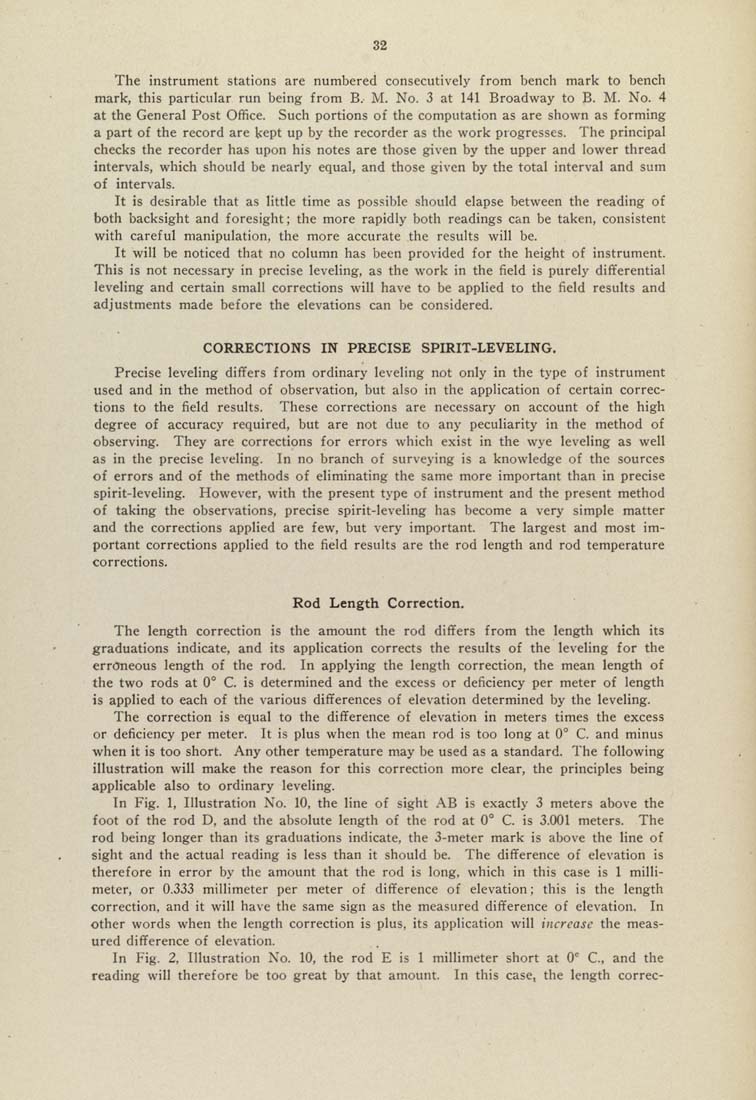32
The instrument stations are numbered consecutively from bench mark to bench
mark, this particular run being from B, M. No. 3 at 141 Broadway to B. M. No. 4
at the General Post Office, Such portions of the computation as are shown as forming
a part of the record are kept up by the recorder as the work progresses. The principal
checks the recorder has upon his notes are those given by the upper and lower thread
intervals, which should be nearly equal, and those given by the total interval and sum
of intervals.
It is desirable that as little time as possible should elapse between the reading of
both backsight and foresight; the more rapidly both readings can be taken, consistent
with careful manipulation, the more accurate the results will be.
It will be noticed that no column has been provided for the height of instrument.
This is not necessary in precise leveling, as the work in the field is purely dift'erential
leveling and certain small corrections will have to be applied to the field results and
adjustments made before the elevations can be considered.
CORRECTIONS IN PRECISE SPIRIT-LEVELING.
Precise leveling differs from ordinary leveling not only in the type of instrument
used and in the method of observation, but also in the application of certain correc¬
tions to the field results. These corrections are necessary on account of the high
degree of accuracy required, but are not due to any peculiarity in the method of
observing. They are corrections for errors which exist in the wye leveling as well
as in the precise leveling. In no branch of surveying is a knowledge of the sources
of errors and of the methods of eliminating the same more important than in precise
spirit-leveling. However, with the present type of instrument and the present method
of taking the observations, precise spirit-leveling has become a very simple matter
and the corrections applied are few, but very important. The largest and most im¬
portant corrections applied to the field results are the rod length and rod temperature
corrections.
Rod Length Correction.
The length correction is the amount the rod differs from the length which its
graduations indicate, and its application corrects the results of the leveling for the
errtjneous length of the rod. In applying the length correction, the mean length of
the two rods at 0° C, is determined and the excess or deficiency per meter of length
is applied to each of the various differences of elevation determined by the leveling.
The correction is equal to the difference of elevation in meters times the excess
or deficiency per meter. It is plus when the mean rod is too long at 0° C. and minus
when it is too short. Any other temperature may be used as a standard. The following
illustration will make the reason for this correction more clear, the principles being
applicable also to ordinary leveling.
In Fig, 1, Illustration No, 10, the line of sight AB is exactly 3 meters above the
foot of the rod D, and the absolute length of the rod at 0° C. is 3.001 meters. The
rod being longer than its graduations indicate, the 3-meter mark is above the line of
sight and the actual reading is less than it should be. The difference of elevation is
therefore in error by the amount that the rod is long, which in this case is 1 milli¬
meter, or 0,333 millimeter per meter of difference of elevation; this is the length
correction, and it will have the same sign as the measured difference of elevation. In
other words when the length correction is plus, its application will increase the meas¬
ured difference of elevation.
In Fig. 2, Illustration No, 10, the rod E is 1 millimeter short at 0" C, and the
reading will therefore be too great by that amount. In this case, the length correc-
|








